FIAT DUCATO 2006 Owner handbook (in English)
Manufacturer: FIAT, Model Year: 2006, Model line: DUCATO, Model: FIAT DUCATO 2006Pages: 238, PDF Size: 3.29 MB
Page 121 of 238
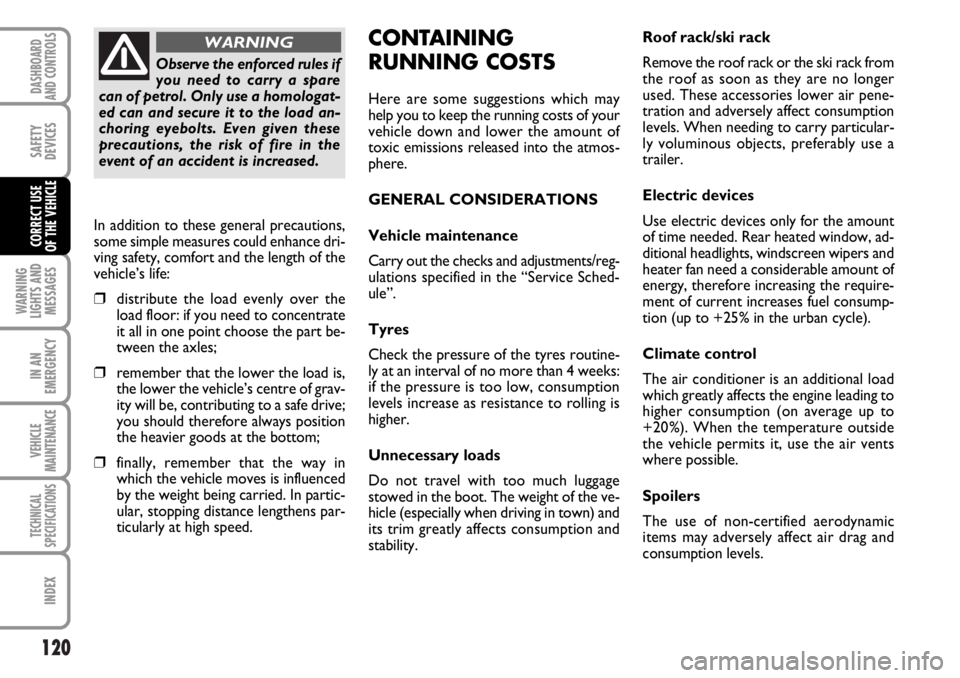
120
WARNING
LIGHTS AND
MESSAGES
IN AN
EMERGENCY
VEHICLE
MAINTENANCE
TECHNICAL
SPECIFICATIONS
INDEX
DASHBOARD
AND CONTROLS
SAFETY
DEVICES
CORRECT USE
OF THE VEHICLE
CONTAINING
RUNNING COSTS
Here are some suggestions which may
help you to keep the running costs of your
vehicle down and lower the amount of
toxic emissions released into the atmos-
phere.
GENERAL CONSIDERATIONS
Vehicle maintenance
Carry out the checks and adjustments/reg-
ulations specified in the “Service Sched-
ule”.
Tyres
Check the pressure of the tyres routine-
ly at an interval of no more than 4 weeks:
if the pressure is too low, consumption
levels increase as resistance to rolling is
higher.
Unnecessary loads
Do not travel with too much luggage
stowed in the boot. The weight of the ve-
hicle (especially when driving in town) and
its trim greatly affects consumption and
stability.Roof rack/ski rack
Remove the roof rack or the ski rack from
the roof as soon as they are no longer
used. These accessories lower air pene-
tration and adversely affect consumption
levels. When needing to carry particular-
ly voluminous objects, preferably use a
trailer.
Electric devices
Use electric devices only for the amount
of time needed. Rear heated window, ad-
ditional headlights, windscreen wipers and
heater fan need a considerable amount of
energy, therefore increasing the require-
ment of current increases fuel consump-
tion (up to +25% in the urban cycle).
Climate control
The air conditioner is an additional load
which greatly affects the engine leading to
higher consumption (on average up to
+20%). When the temperature outside
the vehicle permits it, use the air vents
where possible.
Spoilers
The use of non-certified aerodynamic
items may adversely affect air drag and
consumption levels.
Observe the enforced rules if
you need to carry a spare
can of petrol. Only use a homologat-
ed can and secure it to the load an-
choring eyebolts. Even given these
precautions, the risk of fire in the
event of an accident is increased.
WARNING
In addition to these general precautions,
some simple measures could enhance dri-
ving safety, comfort and the length of the
vehicle’s life:
❒distribute the load evenly over the
load floor: if you need to concentrate
it all in one point choose the part be-
tween the axles;
❒remember that the lower the load is,
the lower the vehicle’s centre of grav-
ity will be, contributing to a safe drive;
you should therefore always position
the heavier goods at the bottom;
❒finally, remember that the way in
which the vehicle moves is influenced
by the weight being carried. In partic-
ular, stopping distance lengthens par-
ticularly at high speed.
Page 122 of 238
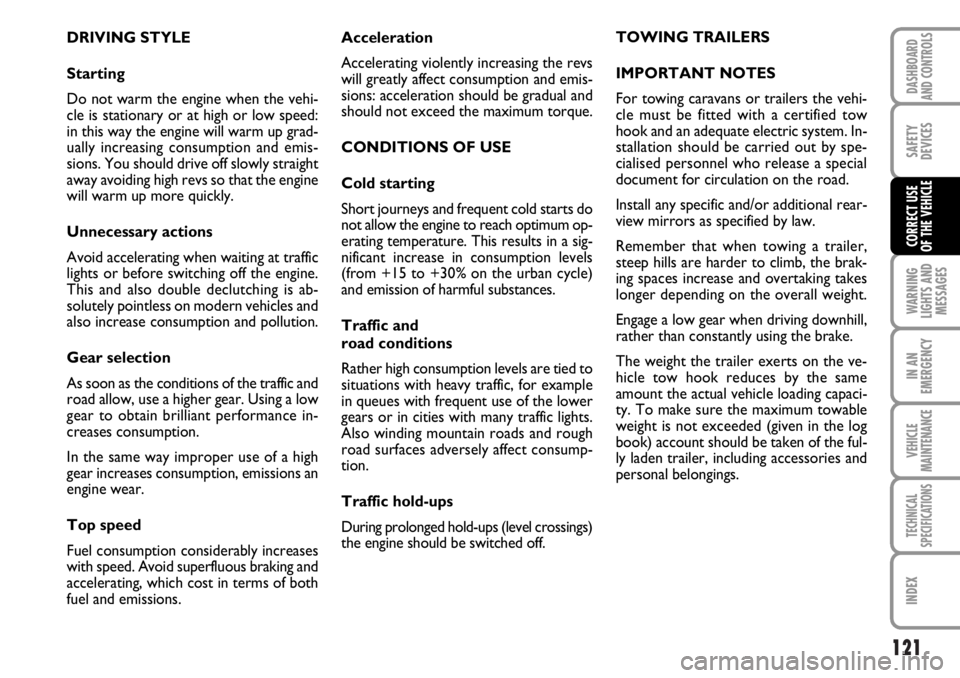
121
WARNING
LIGHTS AND
MESSAGES
IN AN
EMERGENCY
VEHICLE
MAINTENANCE
TECHNICAL
SPECIFICATIONS
INDEX
DASHBOARD
AND CONTROLS
SAFETY
DEVICES
CORRECT USE
OF THE VEHICLE
Acceleration
Accelerating violently increasing the revs
will greatly affect consumption and emis-
sions: acceleration should be gradual and
should not exceed the maximum torque.
CONDITIONS OF USE
Cold starting
Short journeys and frequent cold starts do
not allow the engine to reach optimum op-
erating temperature. This results in a sig-
nificant increase in consumption levels
(from +15 to +30% on the urban cycle)
and emission of harmful substances.
Traffic and
road conditions
Rather high consumption levels are tied to
situations with heavy traffic, for example
in queues with frequent use of the lower
gears or in cities with many traffic lights.
Also winding mountain roads and rough
road surfaces adversely affect consump-
tion.
Traffic hold-ups
During prolonged hold-ups (level crossings)
the engine should be switched off.TOWING TRAILERS
IMPORTANT NOTES
For towing caravans or trailers the vehi-
cle must be fitted with a certified tow
hook and an adequate electric system. In-
stallation should be carried out by spe-
cialised personnel who release a special
document for circulation on the road.
Install any specific and/or additional rear-
view mirrors as specified by law.
Remember that when towing a trailer,
steep hills are harder to climb, the brak-
ing spaces increase and overtaking takes
longer depending on the overall weight.
Engage a low gear when driving downhill,
rather than constantly using the brake.
The weight the trailer exerts on the ve-
hicle tow hook reduces by the same
amount the actual vehicle loading capaci-
ty. To make sure the maximum towable
weight is not exceeded (given in the log
book) account should be taken of the ful-
ly laden trailer, including accessories and
personal belongings. DRIVING STYLE
Starting
Do not warm the engine when the vehi-
cle is stationary or at high or low speed:
in this way the engine will warm up grad-
ually increasing consumption and emis-
sions. You should drive off slowly straight
away avoiding high revs so that the engine
will warm up more quickly.
Unnecessary actions
Avoid accelerating when waiting at traffic
lights or before switching off the engine.
This and also double declutching is ab-
solutely pointless on modern vehicles and
also increase consumption and pollution.
Gear selection
As soon as the conditions of the traffic and
road allow, use a higher gear. Using a low
gear to obtain brilliant performance in-
creases consumption.
In the same way improper use of a high
gear increases consumption, emissions an
engine wear.
Top speed
Fuel consumption considerably increases
with speed. Avoid superfluous braking and
accelerating, which cost in terms of both
fuel and emissions.
Page 123 of 238
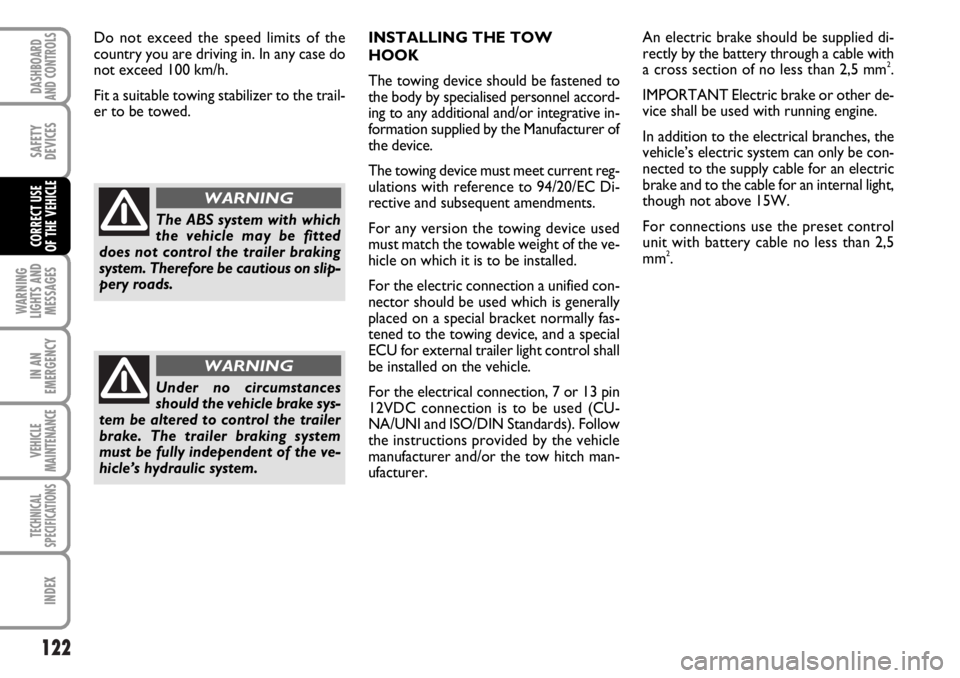
122
WARNING
LIGHTS AND
MESSAGES
IN AN
EMERGENCY
VEHICLE
MAINTENANCE
TECHNICAL
SPECIFICATIONS
INDEX
DASHBOARD
AND CONTROLS
SAFETY
DEVICES
CORRECT USE
OF THE VEHICLE
INSTALLING THE TOW
HOOK
The towing device should be fastened to
the body by specialised personnel accord-
ing to any additional and/or integrative in-
formation supplied by the Manufacturer of
the device.
The towing device must meet current reg-
ulations with reference to 94/20/EC Di-
rective and subsequent amendments.
For any version the towing device used
must match the towable weight of the ve-
hicle on which it is to be installed.
For the electric connection a unified con-
nector should be used which is generally
placed on a special bracket normally fas-
tened to the towing device, and a special
ECU for external trailer light control shall
be installed on the vehicle.
For the electrical connection, 7 or 13 pin
12VDC connection is to be used (CU-
NA/UNI and ISO/DIN Standards). Follow
the instructions provided by the vehicle
manufacturer and/or the tow hitch man-
ufacturer.An electric brake should be supplied di-
rectly by the battery through a cable with
a cross section of no less than 2,5 mm
2.
IMPORTANT Electric brake or other de-
vice shall be used with running engine.
In addition to the electrical branches, the
vehicle’s electric system can only be con-
nected to the supply cable for an electric
brake and to the cable for an internal light,
though not above 15W.
For connections use the preset control
unit with battery cable no less than 2,5
mm
2. Do not exceed the speed limits of the
country you are driving in. In any case do
not exceed 100 km/h.
Fit a suitable towing stabilizer to the trail-
er to be towed.
The ABS system with which
the vehicle may be fitted
does not control the trailer braking
system. Therefore be cautious on slip-
pery roads.
WARNING
Under no circumstances
should the vehicle brake sys-
tem be altered to control the trailer
brake. The trailer braking system
must be fully independent of the ve-
hicle’s hydraulic system.
WARNING
Page 124 of 238
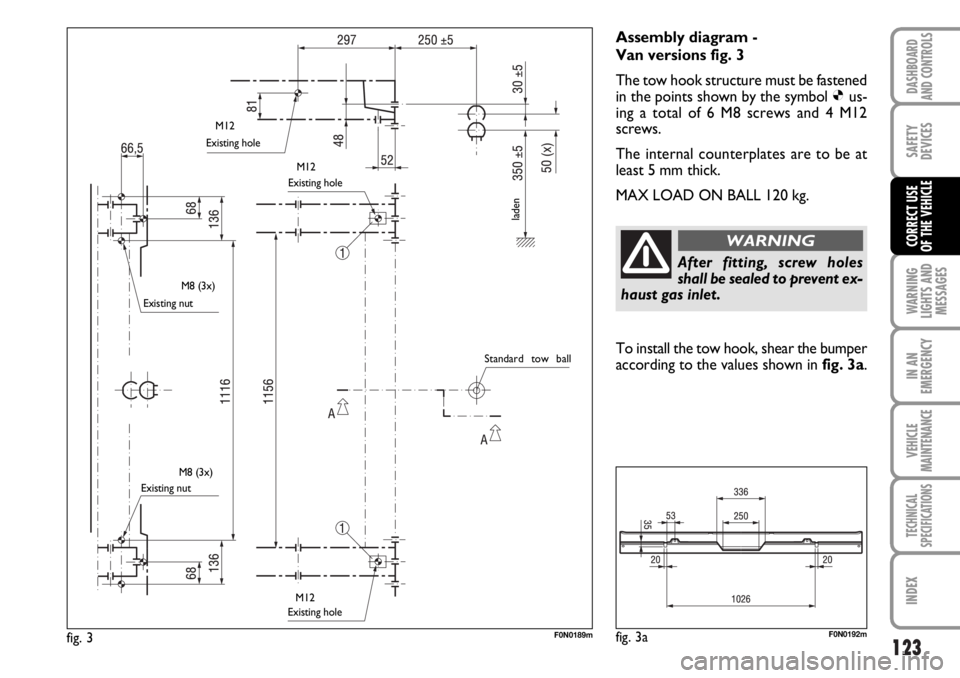
123
WARNING
LIGHTS AND
MESSAGES
IN AN
EMERGENCY
VEHICLE
MAINTENANCE
TECHNICAL
SPECIFICATIONS
INDEX
DASHBOARD
AND CONTROLS
SAFETY
DEVICES
CORRECT USE
OF THE VEHICLE
Assembly diagram -
Van versions fig. 3
The tow hook structure must be fastened
in the points shown by the symbol Øus-
ing a total of 6 M8 screws and 4 M12
screws.
The internal counterplates are to be at
least 5 mm thick.
MAX LOAD ON BALL 120 kg.
After fitting, screw holes
shall be sealed to prevent ex-
haust gas inlet.
WARNING
fig. 3F0N0189m
Existing hole
Existing nut
Existing nutExisting hole
Existing hole
laden
Standard tow ball M12
M12
M8 (3x)
M8 (3x)
M12To install the tow hook, shear the bumper
according to the values shown in fig. 3a.
fig. 3aF0N0192m
Page 125 of 238
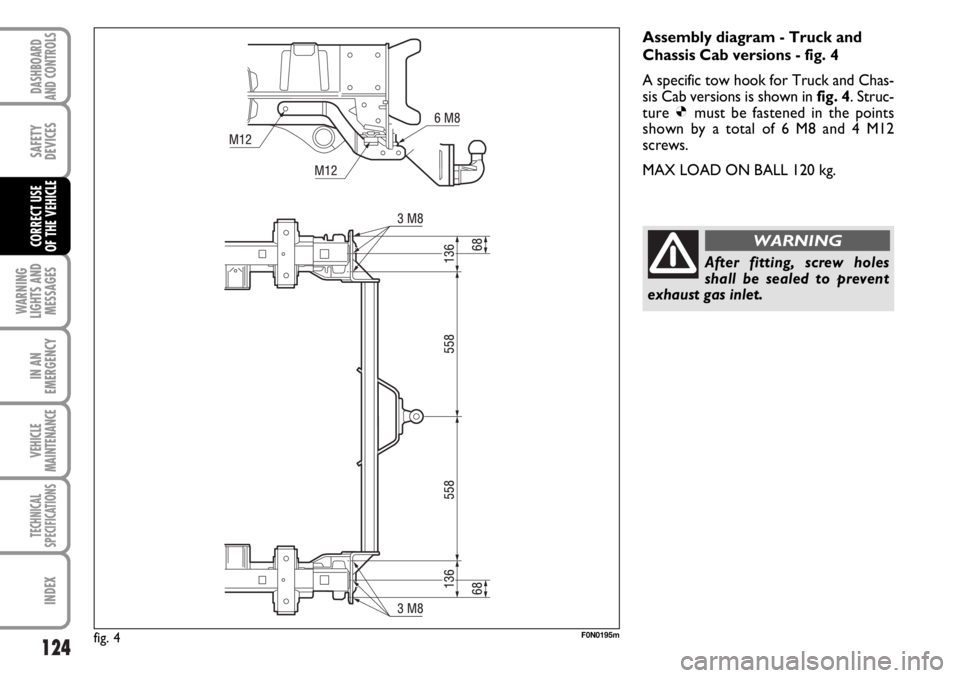
124
WARNING
LIGHTS AND
MESSAGES
IN AN
EMERGENCY
VEHICLE
MAINTENANCE
TECHNICAL
SPECIFICATIONS
INDEX
DASHBOARD
AND CONTROLS
SAFETY
DEVICES
CORRECT USE
OF THE VEHICLE
fig. 4F0N0195m
Assembly diagram - Truck and
Chassis Cab versions - fig. 4
A specific tow hook for Truck and Chas-
sis Cab versions is shown infig. 4. Struc-
ture Ømust be fastened in the points
shown by a total of 6 M8 and 4 M12
screws.
MAX LOAD ON BALL 120 kg.
After fitting, screw holes
shall be sealed to prevent
exhaust gas inlet.
WARNING
Page 126 of 238
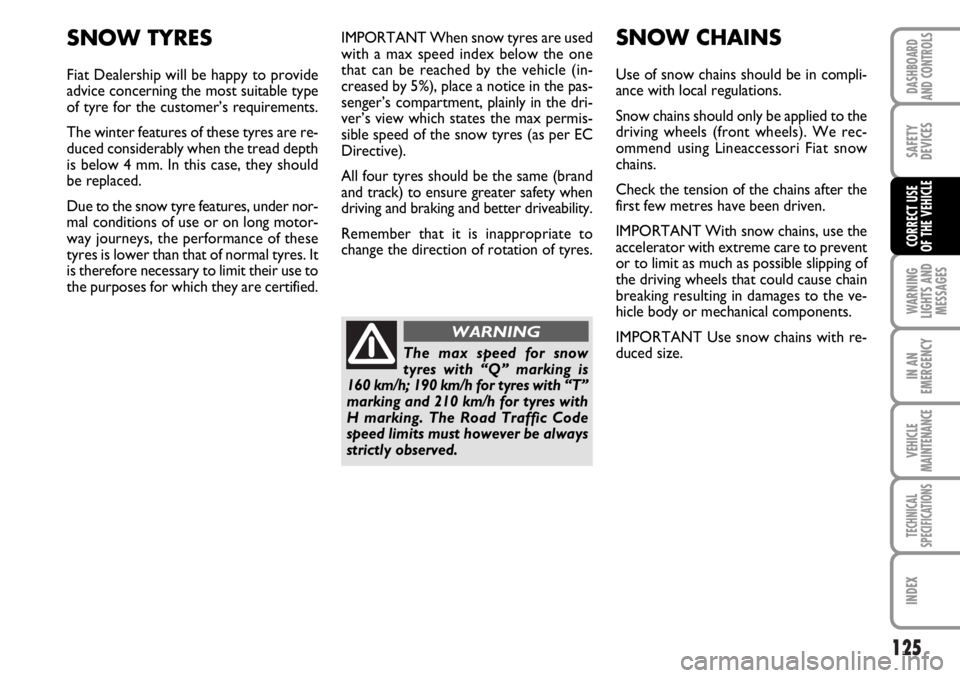
125
WARNING
LIGHTS AND
MESSAGES
IN AN
EMERGENCY
VEHICLE
MAINTENANCE
TECHNICAL
SPECIFICATIONS
INDEX
DASHBOARD
AND CONTROLS
SAFETY
DEVICES
CORRECT USE
OF THE VEHICLE
IMPORTANT When snow tyres are used
with a max speed index below the one
that can be reached by the vehicle (in-
creased by 5%), place a notice in the pas-
senger’s compartment, plainly in the dri-
ver’s view which states the max permis-
sible speed of the snow tyres (as per EC
Directive).
All four tyres should be the same (brand
and track) to ensure greater safety when
driving and braking and better driveability.
Remember that it is inappropriate to
change the direction of rotation of tyres.SNOW CHAINS
Use of snow chains should be in compli-
ance with local regulations.
Snow chains should only be applied to the
driving wheels (front wheels). We rec-
ommend using Lineaccessori Fiat snow
chains.
Check the tension of the chains after the
first few metres have been driven.
IMPORTANT With snow chains, use the
accelerator with extreme care to prevent
or to limit as much as possible slipping of
the driving wheels that could cause chain
breaking resulting in damages to the ve-
hicle body or mechanical components.
IMPORTANT Use snow chains with re-
duced size.
SNOW TYRES
Fiat Dealership will be happy to provide
advice concerning the most suitable type
of tyre for the customer’s requirements.
The winter features of these tyres are re-
duced considerably when the tread depth
is below 4 mm. In this case, they should
be replaced.
Due to the snow tyre features, under nor-
mal conditions of use or on long motor-
way journeys, the performance of these
tyres is lower than that of normal tyres. It
is therefore necessary to limit their use to
the purposes for which they are certified.
The max speed for snow
tyres with “Q” marking is
160 km/h; 190 km/h for tyres with “T”
marking and 210 km/h for tyres with
H marking. The Road Traffic Code
speed limits must however be always
strictly observed.
WARNING
Page 127 of 238
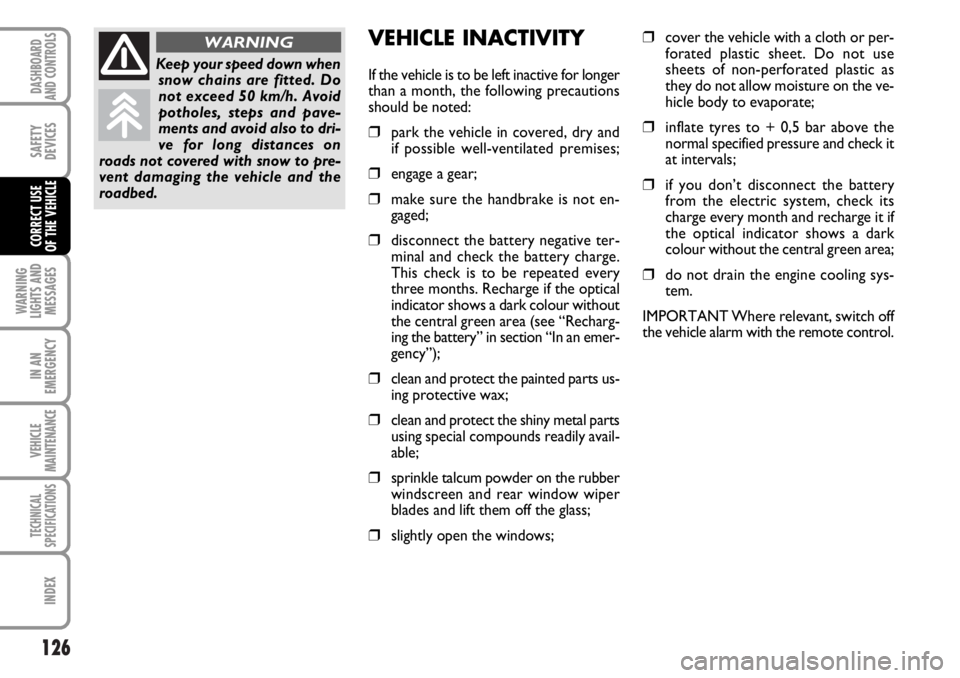
126
WARNING
LIGHTS AND
MESSAGES
IN AN
EMERGENCY
VEHICLE
MAINTENANCE
TECHNICAL
SPECIFICATIONS
INDEX
DASHBOARD
AND CONTROLS
SAFETY
DEVICES
CORRECT USE
OF THE VEHICLE
VEHICLE INACTIVITY
If the vehicle is to be left inactive for longer
than a month, the following precautions
should be noted:
❒park the vehicle in covered, dry and
if possible well-ventilated premises;
❒engage a gear;
❒make sure the handbrake is not en-
gaged;
❒disconnect the battery negative ter-
minal and check the battery charge.
This check is to be repeated every
three months. Recharge if the optical
indicator shows a dark colour without
the central green area (see “Recharg-
ing the battery” in section “In an emer-
gency”);
❒clean and protect the painted parts us-
ing protective wax;
❒clean and protect the shiny metal parts
using special compounds readily avail-
able;
❒sprinkle talcum powder on the rubber
windscreen and rear window wiper
blades and lift them off the glass;
❒slightly open the windows;
❒cover the vehicle with a cloth or per-
forated plastic sheet. Do not use
sheets of non-perforated plastic as
they do not allow moisture on the ve-
hicle body to evaporate;
❒inflate tyres to + 0,5 bar above the
normal specified pressure and check it
at intervals;
❒if you don’t disconnect the battery
from the electric system, check its
charge every month and recharge it if
the optical indicator shows a dark
colour without the central green area;
❒do not drain the engine cooling sys-
tem.
IMPORTANT Where relevant, switch off
the vehicle alarm with the remote control.
Keep your speed down when
snow chains are fitted. Do
not exceed 50 km/h. Avoid
potholes, steps and pave-
ments and avoid also to dri-
ve for long distances on
roads not covered with snow to pre-
vent damaging the vehicle and the
roadbed.
WARNING
Page 128 of 238
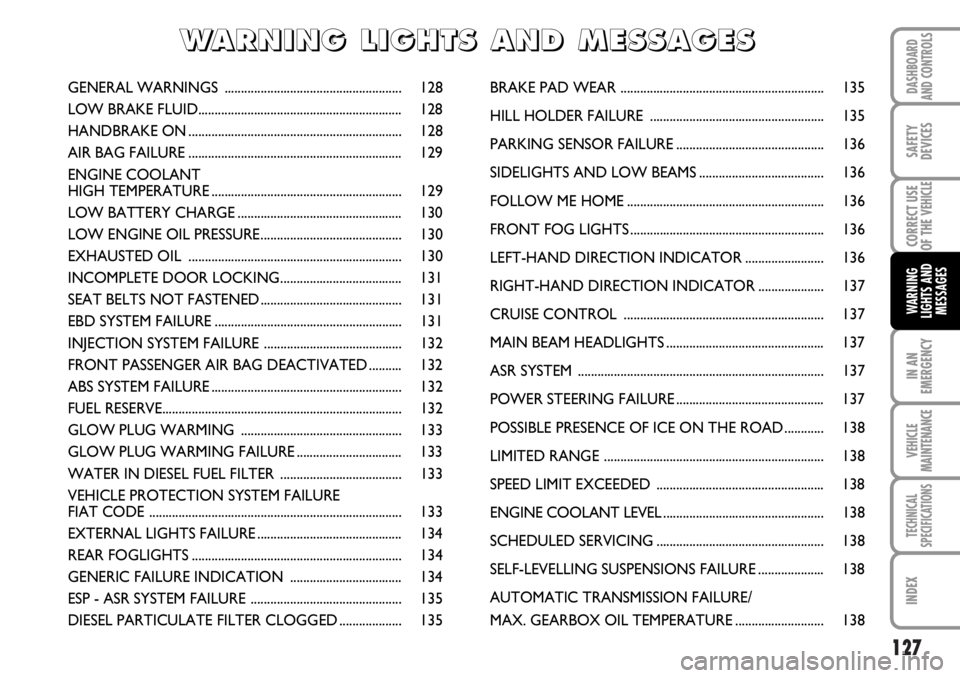
127
IN AN
EMERGENCY
VEHICLE
MAINTENANCE
TECHNICAL
SPECIFICATIONS
INDEX
DASHBOARD
AND CONTROLS
SAFETY
DEVICES
CORRECT USE
OF THE
VEHICLE
WARNING
LIGHTS AND
MESSAGES
GENERAL WARNINGS ...................................................... 128
LOW BRAKE FLUID.............................................................. 128
HANDBRAKE ON ................................................................. 128
AIR BAG FAILURE ................................................................. 129
ENGINE COOLANT
HIGH TEMPERATURE .......................................................... 129
LOW BATTERY CHARGE .................................................. 130
LOW ENGINE OIL PRESSURE........................................... 130
EXHAUSTED OIL ................................................................. 130
INCOMPLETE DOOR LOCKING..................................... 131
SEAT BELTS NOT FASTENED ........................................... 131
EBD SYSTEM FAILURE ......................................................... 131
INJECTION SYSTEM FAILURE .......................................... 132
FRONT PASSENGER AIR BAG DEACTIVATED .......... 132
ABS SYSTEM FAILURE .......................................................... 132
FUEL RESERVE......................................................................... 132
GLOW PLUG WARMING ................................................. 133
GLOW PLUG WARMING FAILURE ................................ 133
WATER IN DIESEL FUEL FILTER ..................................... 133
VEHICLE PROTECTION SYSTEM FAILURE
FIAT CODE ............................................................................. 133
EXTERNAL LIGHTS FAILURE ............................................ 134
REAR FOGLIGHTS ................................................................ 134
GENERIC FAILURE INDICATION .................................. 134
ESP - ASR SYSTEM FAILURE .............................................. 135
DIESEL PARTICULATE FILTER CLOGGED ................... 135BRAKE PAD WEAR .............................................................. 135
HILL HOLDER FAILURE ..................................................... 135
PARKING SENSOR FAILURE ............................................. 136
SIDELIGHTS AND LOW BEAMS ...................................... 136
FOLLOW ME HOME ............................................................ 136
FRONT FOG LIGHTS ........................................................... 136
LEFT-HAND DIRECTION INDICATOR ........................ 136
RIGHT-HAND DIRECTION INDICATOR .................... 137
CRUISE CONTROL ............................................................. 137
MAIN BEAM HEADLIGHTS ................................................ 137
ASR SYSTEM ........................................................................... 137
POWER STEERING FAILURE ............................................. 137
POSSIBLE PRESENCE OF ICE ON THE ROAD ............ 138
LIMITED RANGE ................................................................... 138
SPEED LIMIT EXCEEDED ................................................... 138
ENGINE COOLANT LEVEL................................................. 138
SCHEDULED SERVICING ................................................... 138
SELF-LEVELLING SUSPENSIONS FAILURE .................... 138
AUTOMATIC TRANSMISSION FAILURE/
MAX. GEARBOX OIL TEMPERATURE ........................... 138
W W
A A
R R
N N
I I
N N
G G
L L
I I
G G
H H
T T
S S
A A
N N
D D
M M
E E
S S
S S
A A
G G
E E
S S
Page 129 of 238
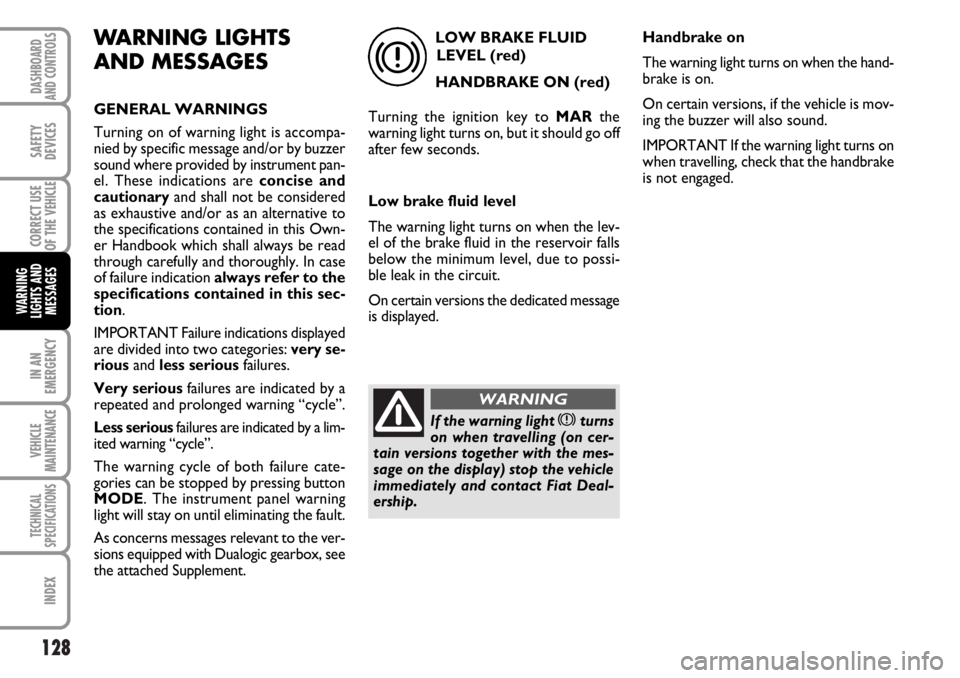
128
IN AN
EMERGENCY
VEHICLE
MAINTENANCE
TECHNICAL
SPECIFICATIONS
INDEX
DASHBOARD
AND CONTROLS
SAFETY
DEVICES
CORRECT USE
OF THE
VEHICLE
WARNING
LIGHTS AND
MESSAGES
WARNING LIGHTS
AND MESSAGES
GENERAL WARNINGS
Turning on of warning light is accompa-
nied by specific message and/or by buzzer
sound where provided by instrument pan-
el. These indications are concise and
cautionaryand shall not be considered
as exhaustive and/or as an alternative to
the specifications contained in this Own-
er Handbook which shall always be read
through carefully and thoroughly. In case
of failure indication always refer to the
specifications contained in this sec-
tion.
IMPORTANT Failure indications displayed
are divided into two categories: very se-
riousand less seriousfailures.
Very seriousfailures are indicated by a
repeated and prolonged warning “cycle”.
Less seriousfailures are indicated by a lim-
ited warning “cycle”.
The warning cycle of both failure cate-
gories can be stopped by pressing button
MODE. The instrument panel warning
light will stay on until eliminating the fault.
As concerns messages relevant to the ver-
sions equipped with Dualogic gearbox, see
the attached Supplement.LOW BRAKE FLUID
LEVEL (red)
HANDBRAKE ON (red)
Turning the ignition key to MARthe
warning light turns on, but it should go off
after few seconds.
Low brake fluid level
The warning light turns on when the lev-
el of the brake fluid in the reservoir falls
below the minimum level, due to possi-
ble leak in the circuit.
On certain versions the dedicated message
is displayed.
x
If the warning light xturns
on when travelling (on cer-
tain versions together with the mes-
sage on the display) stop the vehicle
immediately and contact Fiat Deal-
ership.
WARNING
Handbrake on
The warning light turns on when the hand-
brake is on.
On certain versions, if the vehicle is mov-
ing the buzzer will also sound.
IMPORTANT If the warning light turns on
when travelling, check that the handbrake
is not engaged.
Page 130 of 238
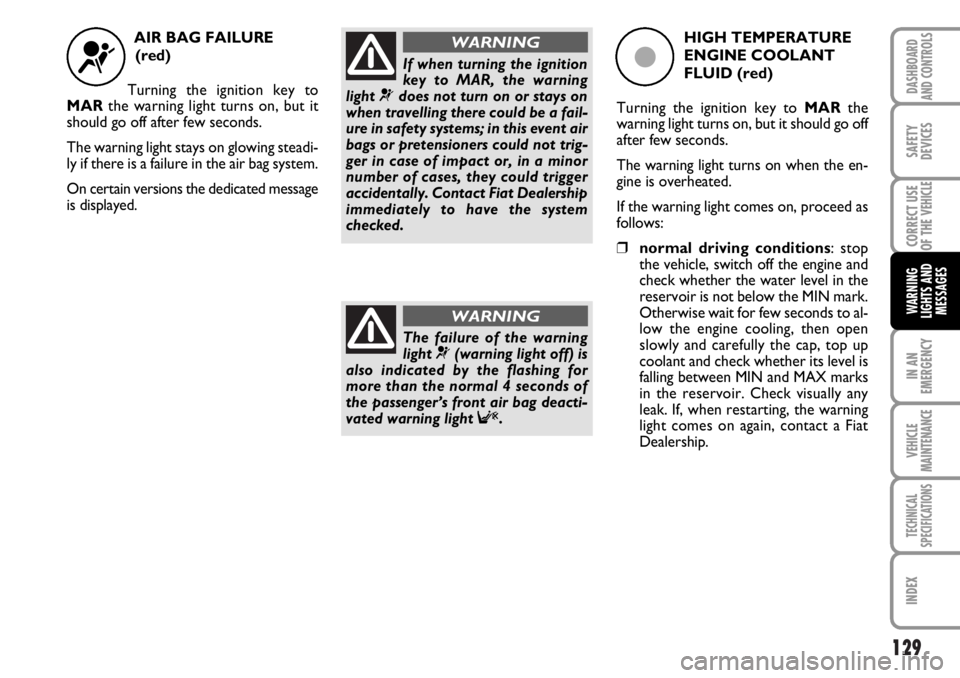
129
IN AN
EMERGENCY
VEHICLE
MAINTENANCE
TECHNICAL
SPECIFICATIONS
INDEX
DASHBOARD
AND CONTROLS
SAFETY
DEVICES
CORRECT USE
OF THE
VEHICLE
WARNING
LIGHTS AND
MESSAGES
AIR BAG FAILURE
(red)
Turning the ignition key to
MARthe warning light turns on, but it
should go off after few seconds.
The warning light stays on glowing steadi-
ly if there is a failure in the air bag system.
On certain versions the dedicated message
is displayed.
¬If when turning the ignition
key to MAR, the warning
light ¬does not turn on or stays on
when travelling there could be a fail-
ure in safety systems; in this event air
bags or pretensioners could not trig-
ger in case of impact or, in a minor
number of cases, they could trigger
accidentally. Contact Fiat Dealership
immediately to have the system
checked.
WARNING
The failure of the warning
light ¬(warning light off) is
also indicated by the flashing for
more than the normal 4 seconds of
the passenger’s front air bag deacti-
vated warning light F.
WARNING
HIGH TEMPERATURE
ENGINE COOLANT
FLUID (red)
Turning the ignition key to MARthe
warning light turns on, but it should go off
after few seconds.
The warning light turns on when the en-
gine is overheated.
If the warning light comes on, proceed as
follows:
❒normal driving conditions: stop
the vehicle, switch off the engine and
check whether the water level in the
reservoir is not below the MIN mark.
Otherwise wait for few seconds to al-
low the engine cooling, then open
slowly and carefully the cap, top up
coolant and check whether its level is
falling between MIN and MAX marks
in the reservoir. Check visually any
leak. If, when restarting, the warning
light comes on again, contact a Fiat
Dealership.
ç